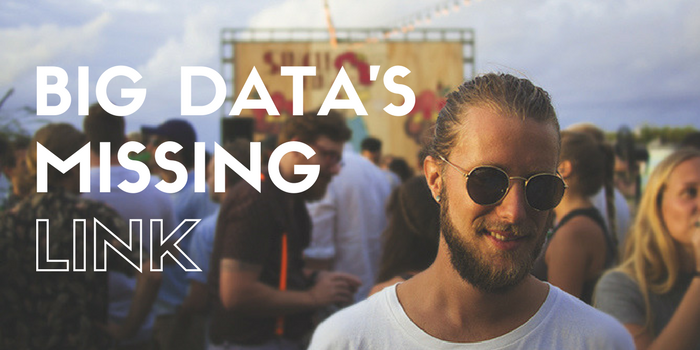As seen on Techvibes: Big Data Lacks One Essential Ingredient: Emotional Attribution
Big data is like a teenager’s first relationship. They knew they wanted one, but now that they have one... they have no idea what to do with it.
Collecting hordes of fan data was a central tenet of every major marketing campaign in 2016. Anonymized data, sales data, third-party data, etc. - everyone wanted it, and many paid a fortune for it. CRM giants promised to capture every data point and interaction for a pretty penny.
But how many of these companies put their data warehouses to work? Does stalking and storing a fan's every move truly improve your marketing? Working with entertainment's biggest players revealed that there's more to targeting than history.
Interaction timelines are important, but humans are ever changing. Past behaviour is not always the best predictor of future purchasing decisions. Enjoying something before doesn't mean you want it now - especially in music. So, what's missing from big data?
Big data misses emotional attribution. Until you understand relationships and motivation in real-time, you'll never achieve optimal ROI.
3 Essential Elements of Emotional Attribution
FANS FEEL.
Emotional states motivate us to buy and experience different things at different times.
Two 24-year old males buying a ticket to a game for the first time appear the same from big data's perspective. Yet, when you consider their emotional intent, you realize they're very different.
One customer recently moved to a new city. He's a lifelong fan of a team that happens to be visiting in your stadium. If you retarget him with ads to see your city's team, you're wasting your money. He only bought this once out of nostalgia because he was homesick.
Your other customer has no team affiliation at all. He attended his first game ever because his new partner is a die-hard fan with a 10 pack of tickets. Their first date was a memorable hit thanks to the overtime highlight reel buzzer beater. You now have a huge opportunity to sell them both full season tickets so they can relive the memory again and again. He bought to connect with someone he cares about - and will continue to do so if given the chance.
Big data can tell you who bought what, when. But it will never tell you why someone bought. You must go beyond big data to be specific about how you target your fans.
FRIENDSHIPS MATTER.
Not only do we buy things based on friend suggestions, we often buy things for our friends.
Big data would look at a new customer who spent $1,200 on tickets to their music festival as a big spender. They'd hit them with luxury accommodations, VIP experiences and expensive merchandise.
It would fail to realize that their new fan is actually a college student buying for four friends. They'd fail to cater their ads to their needs, and would completely miss the other three new leads. Understanding that these four fans acted as a group with a leader changes everything.
Our ever-adapting friend networks affect our buying decisions. Big data sees connections between data points, but ignores dynamic relationships between people. Unless you’re Facebook or Google, targeting with common characteristics or activity triggers will only get you so far.
PEOPLE CHANGE.
Our emotional and social contexts are always shifting. If you spend too much time relying on the past, you'll miss the present moment.
When a Spotify user engages with a new set of artists, big data adds the new data on top of previous listening habits. It'll continue to target that fan for opportunities to see past and present artists.
But this could be a fatal mistake. Big data would fail to reveal that your fan revamped their playlists because they just ended a relationship. Every song that reminds your fan of their ex is a shot to the heart. Targeting ads to see those artists is a surefire way to get blocked. Even if they listened to that artist for years, they never want to hear them again. You need to know when their interests change and act accordingly.
Big data is cumulative. Every interaction builds on top of historical trends. This works well for predictable data sources, but humans are fickle. Dramatic shifts in our interests and friend groups can happen in a moment. If we don't take these into account, our retargeting becomes old news at the drop of a hat (or relationship).
Big data is too bloated to keep up. Until you target fans in real-time, you'll irritate them at best and offend them at worst.
How to Solve Big Data Bloat
Just as the web graduated from 1.0 to 2.0, your CRM needs a relational upgrade. Consumers make up communities, and your relationship management system should reflect that.
Big data is the big picture. When you’re overwhelmed with data bloat, looking at small data can help you narrow down to what’s important. Then you’ll know the right approach to tapping into your big data and optimizing your targeting. There's nothing wrong with collecting historical data. You just need to layer social and interest data on top of it in real-time to provide emotional context.
Even without big data, you can still optimize your targeting with a CRM 2.0. Collect and analyze real-time indicators of relationships and interests. Listen to user-generated content published by your fans to social. Use social login to collect updated contact information and map social graphs. Target ads to fans with social influence on their peers.
Take your big data to the next level by tracking emotional attribution. Only then can you optimize the ROI of your ads and achieve viral success.
Need to see it to believe it? Read how Voodoo Festival earned 40X ROI using this exact strategy in our free white paper.
